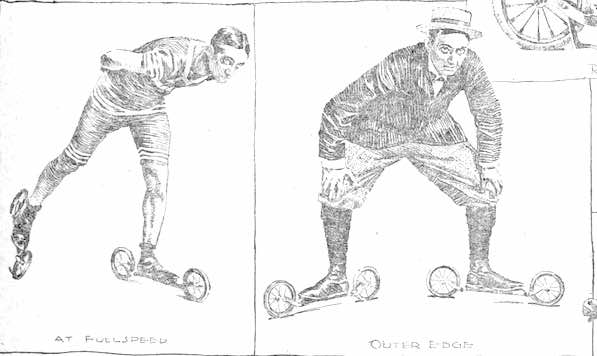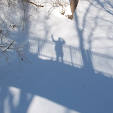A short summary of the family on the blog Skate Guard helps explain why the family is interesting. Four members of the family are buried in Weston Cemetery: Earle Reynolds, his wife Nellie Donegan, and her two daughters, Helen Reynolds King and Maude Reynolds LaMaire.
Below is the best picture of Earle Reynolds that I could find on the Internet. I do not know what the date of the picture is.
I found two interesting articles about him, both in the New York Journal and Advertiser from 1897. They had been digitized with the text extracted. That text had a number of errors and I have tried to correct them where I could. Both had pictures, some of which I am including. Here they are.
New York Journal and Advertiser (New York [N.Y.]), August 2, 1897
Reynolds on Bicycle Skates
Was Too Fleet for Wheelmen.
RACED ON THE BOULEVARD
Something new on cushion tires appeared on the Boulevard yesterday morning. It was a man riding on bicycle skates. The man was Earle Reynolds, the champion ice and roller skater, and he created a sensation. With apparent ease he glided all around bicycle riders, seemingly without any more effort than is usually exerted by a man in walking.
The bicycle skate has many points in common with the old roller skate, but Reynolds claims it is far superior in construction. Instead of four small boxwood wheels, as the roller skate had, the bicycle skate has two larger pneumatic-tired wheels, one placed in front of and one behind the body proper of the skate. The axles of the wheels are equipped with ball bearings, and Reynolds says there is absolutely no effort in propelling them. Of course, the skates run best on asphalt. but the young man who is exploiting them claims they are far easier of locomotion on a dirt road than a bicycle is. Fancy skating is possible with the bicycle skate, as Reynolds evinced yesterday by forming figure eights, grapevines and other standard designs of skaters on the smooth asphalt pavement of One Hundred and Sixth street. The mode of propulsion with them is about the same as that necessary with ice skates.
Reynolds is quite confident that the bicycle skate will prove a formidable rival of the bicycle. He claims that skating Is far less tiresome than pedalling[sic], and advances as an argument in favor of the skates that when the roads are bad the wearer of them can take them off and carry them without discomfort. They are less likely to suffer damage, he asserts, and can be repaired easier and cheaper than a bicycle can. In any event the bicycle skate is attracting interest.
(Earle Reynolds, the Bicycle Skater, on the Boulevard
Wheelmen had a new and a swift competitor yesterday. A young man with skates clamped to his feet glided past them with long, easy strides. The skates had two wheels each, were rubber tired and equipped with ball bearings. On the way to Grant's Tomb Reynolds raced against single wheels and tandems and set a fast pace for all.)
New York Journal and Advertiser (New York [N.Y.]), August 15, 1897,
"WILL THE BlCYCLE SKATE OUST THE BICYCLE"
Remarkable Speed Trials on the Cushion-Tired Wheels by Earle Reynolds, the World's Champion Skater.
Is the bicycle doomed? Has its successor already come?
Is the "wheel" of the future to be merely a bicycle or a pair of bicycles strapped to the feet of the rider?
The two canny Scotchmen Robert and George Anderson, of Edinburgh, who invented the bicycle skates, thought they had merely devised a toy, a curiosity, a thing with which to tickle for an hour the fancy of the millions who dote on everything akin to the "bike."
Upon their advent to America the bicycle skates could have reached no more competent hands—or feet—than those of the lithe, lean youth who day after day whirls along on them over the smooth, gleaming reaches of uptown asphalt, leaving whole trains of more or less lumbering wheelmen puffing and humping in his wake.
Earle Reynolds was a skater from the hour of his birth. He was.born to be the world's champion on runners—and rollers, too. He is the fleetest thing, of human shape and amateur rating, that ever buckled a skate strap over his toe. In the roller skating seasons of 1884, 1885 and 1886, throughout the United States and Canada, he won in 112 out of 120 starts. After proving himself a wonder at sprint running and a deemster at hockey-polo he took up ice skating, and last Winter showed his swift heels to the greatest skaters of the world In the International championships.
He has created world's records for all sorts of skating. Here are the figures:
On rollers—Quarter of a mile, 39 seconds; half mile, 1:21 ⅗; one mile, 2:11 ⅕.
On Ice—Fifty yards, 5⅕ seconds; hundred yards, 8⅖ seconds; 220 yards, 17⅗; 500 yards, 38⅗; half mile, 1:11⅘: mile, 2:03 ⅖; two miles, 5:40. All these from standing starts.
And now this master skater is testing the bicycle skates, which he declares are to supersede the bicycle. The pair which were sent to him by the Andersons are, he says, cumbersome, compared with what the improved article will be.
The skate—each one weighs two pounds—consists of a thin bar of brass, with a fork at either end. In which the wheels, six Inches In diameter, are set. The rims are of steel, and the tires of cushion rubber. The pneumatic tire, it is conceded, is out of the question, as the pressure upon them is largely lateral. The skates are equipped with straps for ordinary road use, but these Reynolds has removed and attached the regulation racing shoes firmly to the plates with rivets. The upward curve at each end of the skate serves the double purpose of accommodating a larger wheel and bringing the foot nearer to the ground, thus facilitating locomotion, on the same principal as the lowering of the crank hanger in a bicycle.
The most striking thing about the skate Is the perfect adjustment of the ball bearings. One of the little wheels, one started free, will spin until further no;.c The improved skates are to be made lighter than the present form. The pair will weigh three pounds.
When Reynolds first donned the strange, miniature bicycles, and with a long, strong, graceful stride swept up Fifth avenue to One Hundred and Tenth street, men and women stared at him as the savages of San Salvador did at Columbus. Faster and faster the pace grew. Twice in the course of his journey to One Hundred and Tenth street, well-meaning policemen tried to stop him, but he sped along, swift and still and smiling. Behind him, like the tail of a comet, the cyclers came. If they could all have kept pace with him. which he refuses to believe, the fear of arrest kept them from buckling down to the work, and he led the procession, uninterrupted, for there is no law on the statute books that forbids skating on bicycle skates at any rate of speed you may fancy.
Whatever may be the ultimate speed possibilities of the bicycle skates, Champion Reynolds is convinced that they will, after some essential improvements shall have been made, supplant the wheel in a great measure, for ordinary purposes of travel and exercise.
"I believe," he said yesterday, as he rested after a series of intricate evolutions on the asphalt about the Park entrance, "that they furnish a healthier form of exercise than the bicycle. They are more convenient. They are as comfortable to travel on, over a country road, as a bicycle.
It was a wet morning when Reynolds first started out to make any trial of speed for conventional racing distances, and he slipped at the start of the 100 yards; but even after that pulled it off in 11 seconds. The 220 yards he covered in 20 seconds, the quarter-mile in 40, the half in 1:21, the mile In 2:54.
On the second day's trials, and with a tandem pacemaker, he cut down the time a second for the 220, seven seconds for the half-mile, and 21⅕ seconds for the mile. Then he turned off two miles in 5:40. So day after day. as he grew more accustomed to the new form of locomotion, he kept knocking seconds off the time.
"They can be easily put on and taken off, and when you remove them, to cross a stream, or go into a shop, you take them under your arm or throw them over your shoulder. Then you've got 'em. No curbstone thief can come along and lug them off while you are transacting business indoors."
" What about covering distances?"
"Well. I went fourteen miles this morning, over various sorts of going, in fifty-four minutes, and didn't tire myself."
**********
Bicycle skates never replaced bicycles, so Reynold's prediction was wrong. I tried to find more about bicycle skates on the Internet but came up empty.
Reynolds and Donegan spent several years on the vaudeville circuit as this ad from 1906 indicates.










No comments:
Post a Comment